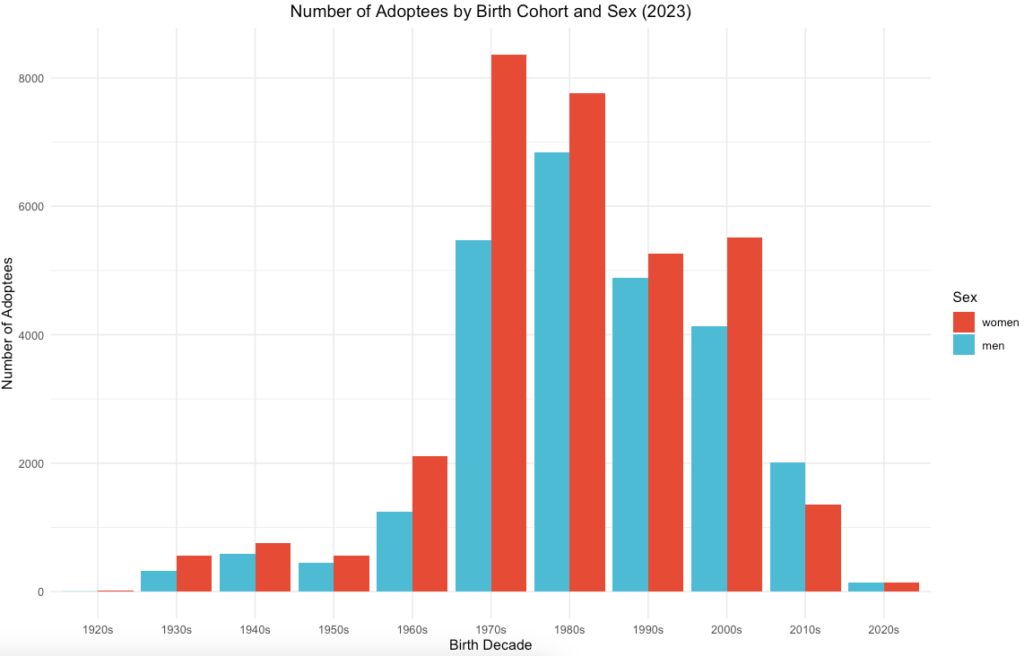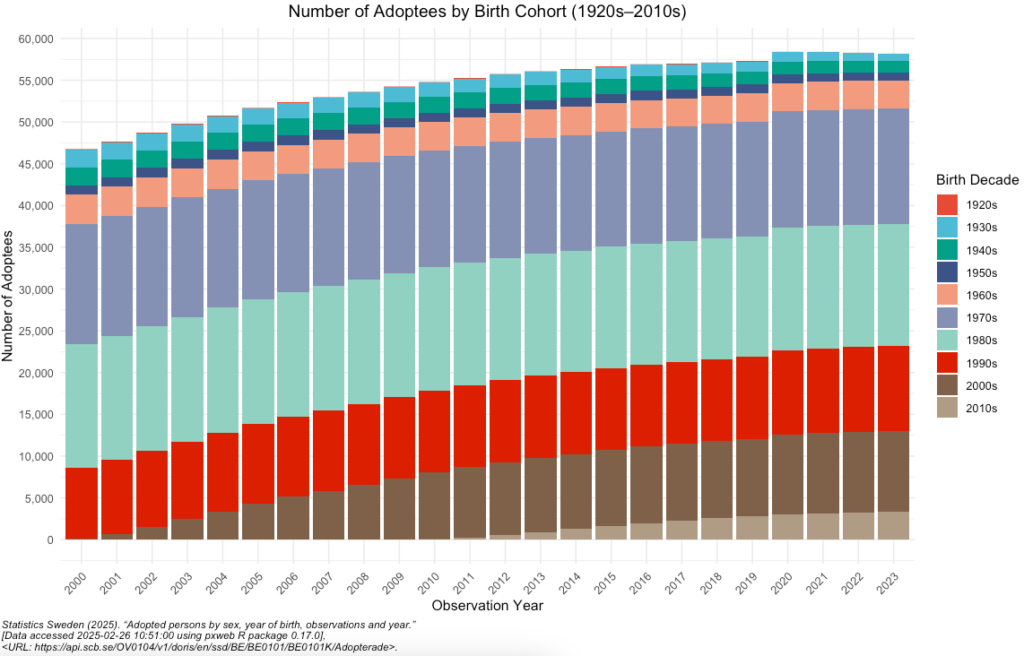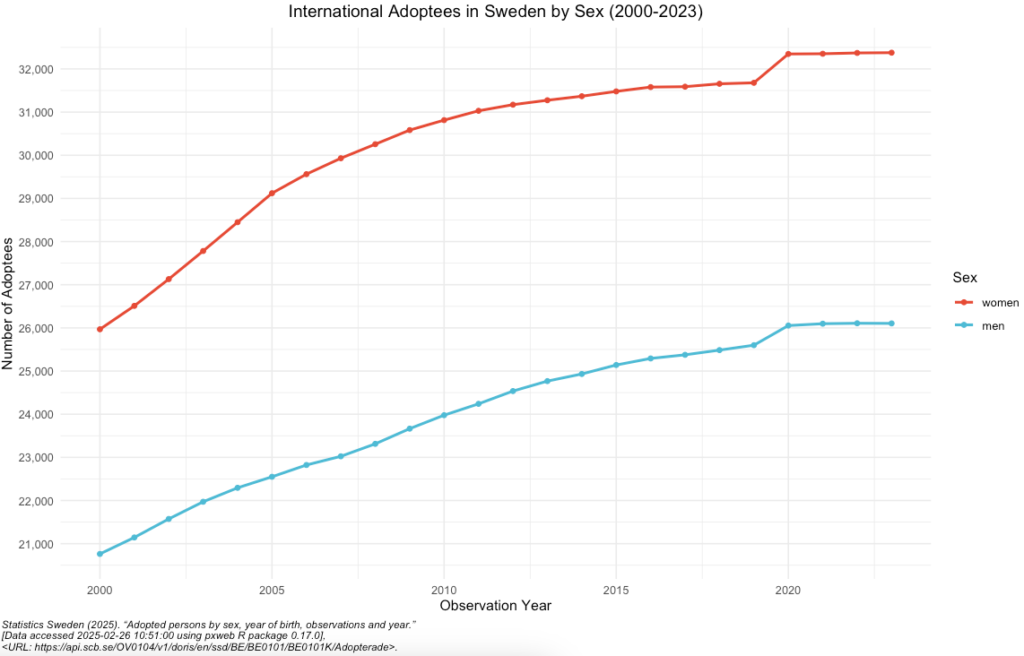Transnational Adoptee Population in Sweden (2000–2023)
Transnational adoptees represent a significant part of Sweden’s demographic history. With this post, I aim to provide an updated visualization of the total international adoptee population in Sweden, using the latest available data from Statistics Sweden (Statistiska Centralbyrån, SCB), retrieved via their API as of 2025-02-26.
Unfortunately, this dataset does not specify adoptees’ countries of birth. It only represents individuals registered as adopted persons in Sweden born outside of Sweden, meaning we cannot separate adoptees by their country of origin.
Please note that the dataset reflects the number of adoptees registered as residents in Sweden during each observation year. The annual count does not indicate how many people were adopted in a given year. The difference in numbers between two years does not represent the number of new adoptees, as it also includes those who have passed away, emigrated, or re-immigrated.
Transnational Adoptee Population by Birth Cohort and Sex (2023)

The grouped bar chart displays the number of adoptees by birth cohort and sex in 2023. It shows that adoptees born in the 1970s and 1980s make up the largest groups, reflecting the peak period of transnational adoptions.
A notable gender difference is observed across all cohorts, with more women than men in most birth decades, particularly in the 1970s, 1980s, and 2000s.
In more recent birth cohorts (2000s and 2010s), the number of adoptees has significantly declined, indicating the global decrease in international adoptions. The presence of a small number of adoptees from earlier decades (1920s–1950s) reflects aging adoptees who remain in the dataset.
Historic Transnational Adoptee Population in Sweden by Birth Cohort (2000–2023)

This stacked bar chart illustrates the distribution of adoptees in Sweden over time, segmented by birth cohort. The data again shows that adoptees born in the 1970s, 1980s, and 1990s represent the largest groups, reflecting the peak years of international adoption.
Over time, the proportion of older adoptees (1920s–1960s) declines, while newer cohorts (2000s and 2010s) grow but remain relatively smaller, indicating a significant decrease in transnational adoptions in recent decades.
Historic Transnational Adoptee Population in Sweden by Sex (2000–2023)

This line chart illustrates the number of international adoptees in Sweden over time, split by sex, from 2000 to 2023. The data highlights a consistent difference in numbers between men and women in the adoptee population throughout the observed period.
- Steady Historic Increase: The number of adoptees in both groups grew over time, reflecting the ongoing practice of transnational adoption.
- Gender Distribution: The number of women adoptees has remained higher than men, a trend seen in many international adoption programs.
- Plateau in Recent Years: Around 2020, the growth levels off, suggesting that fewer international adoptees are entering the dataset, likely due to increased regulation, tightening of intercountry adoption laws, and political shifts emphasizing domestic child welfare alternatives.
This chart provides valuable insight into long-term adoption trends, including gender distribution and the slowing rate of international adoption in Sweden.
Key Takeaways
These visualizations provide an updated view of Sweden’s transnational adoptee population, highlighting long-term trends in gender distribution, birth cohorts, and overall numbers. The data reveals both the historical scale of transnational adoption to Sweden and its recent decline, reflecting shifts in global adoption policies, increased regulation, and changing societal perspectives on transnational adoption.
One key aspect missing from this dataset is the country of origin of adoptees, which is something I am particularly interested in exploring further. To gain a deeper understanding, I intend to reach out to Statistics Sweden to inquire whether supplementary data on adoptees’ birth countries can be provided. This would offer valuable insights into how adoption patterns have changed based on different sending countries.
Notes on Data & Methodology
This analysis was conducted using Statistics Sweden’s (SCB) open data API and retrieved using the pxweb R package. The data covers international adoptees by year, sex, and birth cohort from 2000 to 2023.
Data Granularity & Further Analysis:
This dataset provides aggregated counts of international adoptees in Sweden with the following dimensions:
- Observation Year (2000–2023): The year in which adoptees were counted as residents in Sweden.
- Year of Birth (Grouped into birth cohorts): Allows analysis of different generational trends.
- Sex (Male/Female): Enables demographic comparisons.
- Count: The number of adoptees registered in Sweden for each category.
There are many ways to explore this data further. If you’re interested in visualizing a specific cohort by sex or other breakdowns, feel free to reach out! 📩
Data Source:
Statistics Sweden (2025). “Adopted persons by sex, year of birth, observations, and year.”
[Data accessed 2025-02-26 10:51:00 using pxweb R package 0.17.0],
R Package Used:
The data was retrieved using pxweb, an R package for interacting with PXWEB APIs.
GitHub Repo for the pxweb package:
pxweb package written by Mans Magnusson, Markus Kainu, Janne Huovari, and Leo Lahti (rOpenGov). pxweb: R tools for PXWEB API.
Disclaimer:
I do not work at Statistics Sweden (SCB), and the interpretations in this post are based on general assumptions about how official population statistics are structured. As someone working in data, I approach this dataset with a methodological perspective, but I encourage others—especially those with expertise in demographic statistics—to share insights or corrections if needed.